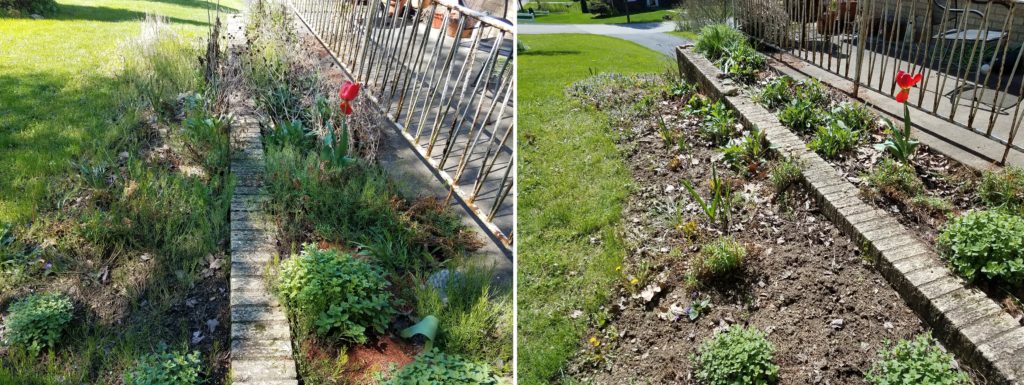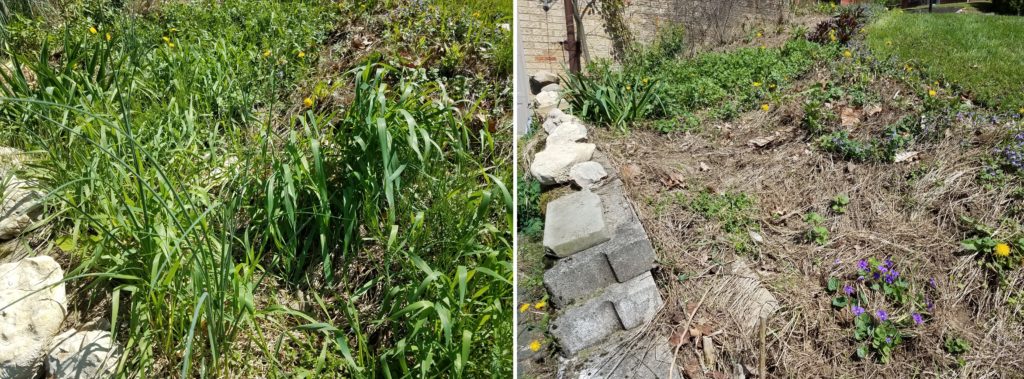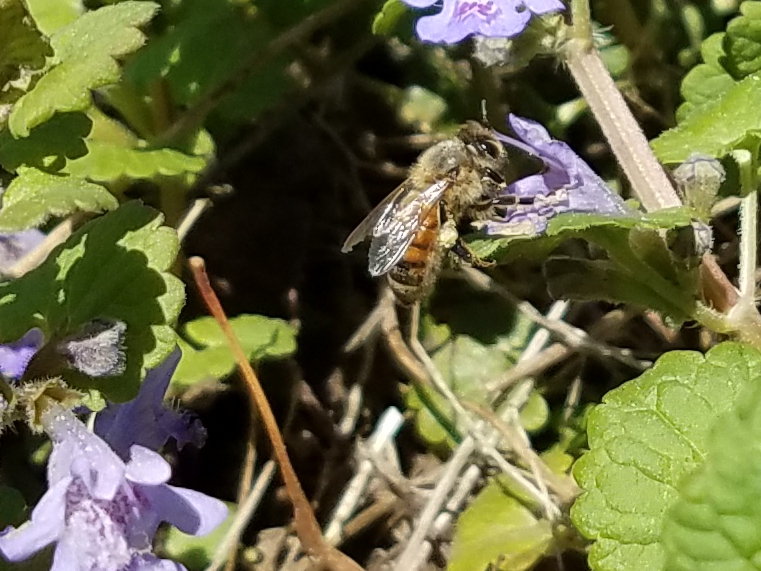I’m sure our neighbors have been horrified as they pass by our house because my garden has looked horrible since fall. It was full of dead stalks from last year’s annuals and perennials, leaves and other debris that have collected over the fall and winter, and a massive amount of unchecked weeds popping up all over the place. Part of the reason for this situation is because I have had no time to do any gardening, but also because I’m doing my part to protect any beneficial creatures that may be living in my garden. Yes, you can justify laziness with sustainability!
Unfortunately, in looking for information on pollinator gardens, you can find a lot more details on how to plant one than how to maintain one. While I will probably write about how to design a pollinator garden in the future, this post has information that works for any garden. In case you’re like me and haven’t started your spring gardening yet, I hope this information will prove useful for you. For this topic, I will be relying on (in this order) the expertise of my aunt (who has a master’s degree in horticulture and owns a garden center), the scant websites I found on responsible gardening, and my own experiences with my garden.
I started planting my pollinator garden last year, and it is still very much a work in progress. We have a sizeable yard with a lot of potential for landscaping, but I didn’t even finish one garden bed last year (for both time and financial reasons). Since this is my first spring tending this garden, I want to make sure I’m making responsible decisions for the flora and fauna. I do know that many common gardening practices look pretty but are not beneficial for the garden or its inhabitants.
Ideally, spring gardening work, such as clearing out beds, cutting old growth, and planting anything new, should wait until after the temperatures are reliably in the 40s overnight or after the last risk of a hard frost. I grew up with a frost date of early May in eastern PA, but we’re a little bit behind the curve here in Pittsburgh [insert jokes here]. According to this handy chart, our frost date is May 26, meaning as of this post, I still have four weeks before I should really be doing anything substantial.[1]
As much as I would love to wait and be on the safe side, I was coming up on a rare weekend of available time and a reasonable weather forecast. While it is still a little early to be doing some of this work, I needed to make some progress while I could. I had specific concerns about each of my three potential gardening activities for this weekend: cutting dead growth, weeding, spreading compost. After consulting some experts, here is what I found…
Pruning and cutting last year’s growth
After the flowers have died in the fall, my garden does look a little like a haunted house by Halloween. Many gardeners do a fall cleanup to avoid such an appearance. While cutting back stalky perennials certainly looks a lot better through the bleak winter months, they serve a very important purpose.
Many insects lay eggs in the hollow stalks, leaving them there until it’s warm enough to emerge in the spring. Enthusiastic gardeners who cut back their gardens early in the season are not only getting rid of last year’s growth, but this year’s insects too.[2]

It made me very happy to learn that it’s much better for your garden to just leave it alone for as long as you can in the spring. As it happens, I don’t have the time to be out there picking up every leaf the minute the snow melts, nor do I want to be out in the cold weather any longer than I have to be. It’s a win-win for me and nature.
Ultimately I spent a good bit of time this weekend cutting back the stems from last year’s plants, but I stacked them all in the corner of the porch, where they can still be warm and get sunlight. If anyone is wintering over inside any of those hollow stalks, they can emerge when they’re ready.
Weeding and clearing debris
I understand the desire to have perfectly manicured beds that are free of debris year-round, but again, I don’t know who has the time to stay on top of that. Additionally, here again is a reason not to: cleaning out the garden removes potential shelter for insects. There are ground-dwelling bees and other insects that rely on dead leaves and debris for shelter. The more you can leave there, the better for your critters.[3]
However, as I mentioned, my garden was getting overrun pretty quickly with new weeds, on top of the dead debris from last year. Therefore, I decided to pull only new weeds that were currently green and growing, leaving some of the dead grasses and things from last fall until the weather improves.

I pulled long-bladed grass and some other weeds that I regularly tangle with every year. However, I did leave all of the ground ivy (a.k.a. Creeping Charlie) that has started to take over the garden, at least for the time being. While it is invasive and chokes out other plants, it is currently blooming, and I did not want to remove any possible pollen source for early spring foragers. It doesn’t bloom for long, and I’ll take it out once the blossoms are gone.
I did not expect to get such great validation for that decision, but while I was cleaning up after weeding, I saw a honey bee with big pollen stores making her way from purple flower to purple flower. I spent several minutes sitting and watching her while she worked, and she let me get a few photos. While I was out there, I also saw a butterfly, a carpenter bee, and some small flies floating around. It made me supremely happy to sit outside in the sun, in my garden, and watch little creatures taking advantage of what I constructed for them.
Spreading compost and/or mulch
The last thing that concerned me going into this weekend was if it was too early to spread compost. I have a 55-gallon compost barrel that was full and ready to go. However, I was also concerned about covering the garden with too thick a layer, thereby smothering bugs or perennials that were just about on their way up. However, given the size of my garden, that amount of compost wouldn’t cover anything deeply, so my aunt assured me that a thin layer wouldn’t hurt anybody. I’ll be doing a post about my compost setup in the near future.
While I had a little bit of daylight left to burn, I decided to move some plants for aesthetic reasons – something I had wanted to do last year but never had the chance. This year’s growth was just starting to come up on what I moved (black-eyed Susans and yarrow), so they should all be fine in their new locations. We will find out in the coming weeks.

I didn’t get many honeybees last year, but I’m hoping that seeing one so early is a good sign.
My one concern about what I did is that in digging new holes, I pulled up a lot of clay-heavy soil, which needed to be spread out on top of the ground nearby. I was careful to break up large pieces and spread out the soil as thinly and widely as possible, but I couldn’t help but notice two carpenter bees flying around in that specific area, landing on the ground, digging around a little, and looking around for what I can only imagine was their home. I sincerely hope that if I covered up their burrow, they, as burrowing insects will be able to get back in (or other members of their hive will be able to get back out.) It just goes to show that you can never be too careful when it comes to protecting your garden’s inhabitants.
I will have many more garden updates and photos in the coming months, but in the meantime, do you have a garden project that makes you proud or something that you want to do? I’d love to hear about it in the comments below.
Thanks for reading!
[1] http://www.victoryseeds.com/frost/pa.html
[2] https://savvygardening.com/spring-garden-clean-done-right/
[3] http://content.yardmap.org/learn/pollinator-plants-practices/
3 Comments
Elsa Taliard · April 28, 2019 at 9:42 am
Cool stuff! Are carpenter bees and mason bees the same? Someone gave me a mason bee “hive” at Christmas, and I noticed one of the tubes is already filled in. 😀
Alison · April 28, 2019 at 9:54 am
Mason bees are much smaller – they’re fuzzy and look a little disheveled. My mom got a “hive” last year, and I was surprised at how small the holes are.
Carpenter bees, on the other hand, are huge – bigger than bumble bees, with a shiny abdomen. Impossible to miss.
Insect Warfare: Aphids – Radical Moderate · June 13, 2021 at 10:13 am
[…] [5] https://radicalmoderate.online/spring-garden-cleanup/ […]